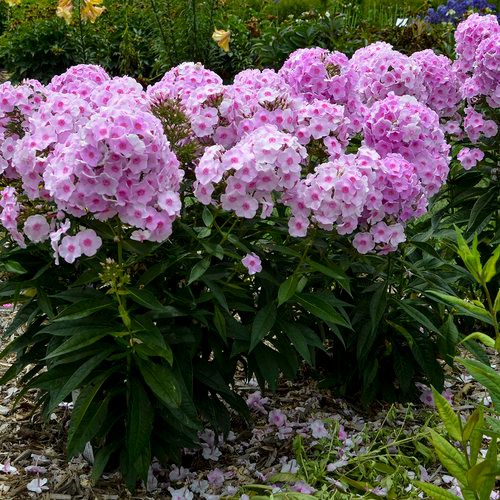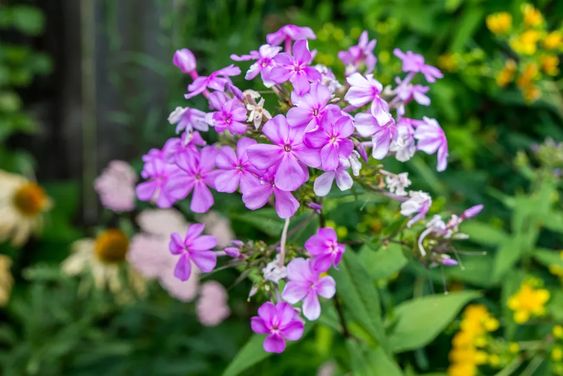The low-maintenance Tall Garden Phlox Plant (Phlox paniculata) brings interest and color to the summer garden. Within the Polemoniaceae family, also known as “Jacob’s ladder,” the Phlox genus is prized for its huge, persistent flowers. The flowers, which grow in panicles at the summits of three to four foot stems, have a faint aroma and come in a broad variety of hues. In addition, these perennials draw butterflies and hummingbirds. Their strong stems also make them an excellent option for cut flowers.
Garden phlox is a relatively tall perennial that grows in upright bunches. In actuality, another frequent name for it is “tall phlox”. Paniculata is the species name for the “panicles” of flowers, or flower heads, that are held atop its stalks. Sometimes the foliage is quite lovely, particularly on the variegated varieties like ‘Nora Leigh.’ Unfortunately, powdery mildew can ruin the leaves’ beauty. Discover how to cultivate and tend to this traditional cottage garden plant.
Garden Phlox Plant Overview

| Botanical Name | Phlox paniculata |
| Common Names | Garden phlox, tall phlox |
| Plant Type | Herbaceous, perennial |
| Mature Size | 2 to 4 ft. tall, 2 to 3 ft. wide (but varies by cultivar) |
| Sun Exposure | Full sun to partial sun |
| Soil Type | Moist but well-drained |
| Soil pH | Neutral |
| Bloom Time | Summer |
| Flower Color | Lavender, lilac, pink, purple, salmon, white |
| Hardiness Zones | 4 to 8, USA (but varies by cultivar) |
| Native Area | Eastern United States |
Garden Phlox Plant Care

Garden phlox flowers require very little maintenance, especially when you consider the value they bring to a landscape. Given a sunny location and well-draining soil, they ought to flourish and return year after year. Even the most serious issue they have, powdery mildew, is rarely lethal but can somewhat ruin their appearance.
To extend the blooming season, deadhead the spent flowers on garden phlox. Weed the area around your plant on a regular basis to prevent weeds from weakening it or depriving it of the water it needs to survive the summer. You want to avoid using insecticides or herbicides that can kill bees and other pollinating insects when you have garden phlox in your yard.
Light Requirements
Full sun in the north and partial sun in the south are ideal for growing garden phlox.
Soil
The greatest conditions for garden phlox are rich, damp soil with adequate drainage.
Watering
Take care not to overwater; just keep the soil evenly moist. Steer clear of overhead irrigation. Instead, aim your garden hose’s nozzle at a downward angle to send the spray toward the ground. Maintaining dry foliage will reduce powdery mildew issues.
Temperature and Environment
Garden phlox is not a suitable choice for Deep South gardeners since it dislikes hot, muggy summers. Mulch can help reduce the effects of heat and humidity by keeping the root zone cool.
Fertilization
This plant prefers a moderately fertile soil. Every year in the spring, fertilize garden phlox with compost.
Propagating Garden Phlox Plant

Divide phlox plants in the early spring to propagate them. With a sharp knife, break your large phlox plant into smaller bunches after digging it out of the ground. Replant these clumps after that. As soon as the ground is workable in the spring, you can also directly sow seeds. Lightly cover seeds with 1/8-inch of dirt. It should germinate in five to ten days.
Potting and Repotting Garden Phlox
To give garden phlox plant the best growing circumstances possible, you must pot it correctly if you intend to grow it in a container. Potting mix is the ideal soil to put in a container since it drains efficiently. Don’t use garden soil because it will likely compact in a container. Compacted soil can lead to root rot from poor drainage, which can be lethal to your plant. Garden phlox grown in pots may require staking or other support due to its height.
Varieties of Phlox
Although there are many different types of phlox, most people only consider the garden phlox (Phlox paniculata) or the creeping phlox (Phlox subulata), which are both regularly grown. Garden phlox plant grows tall and upright, while Phlox subulata stays short and crawls. In the garden, these two types have distinct uses. While garden phlox plant is more likely to be found in the middle or back row of a flower bed, creeping phlox is a ground cover.
Garden phlox blooms in the summer, but creeping phlox blooms in the spring. This is another distinction between the two. In addition, garden phlox plant has considerably larger leaves that die back at the end of the growing season; these leaves are thin at both ends and flare out in the middle, whereas Phlox subulata has needle-like leaves, some of which stay green all winter.
Other phlox varieties consist of:
- Phlox drummondii, sometimes known as drummond phlox, is an annual plant.
- The perennial woodland phlox (Phlox divaricata) is similar to creeping phlox in that it blooms in the spring, but it resembles garden phlox in size.
- The look and timing of blooming are comparable between garden phlox and the perennial spotted phlox (Phlox maculata). When it comes to powdery mildew, it is less problematic than Phlox paniculata.
Common Pests & Diseases
Powdery mildew is a fungal disease that thrives in hot, humid environments that affects garden phlox. Look for garden phlox plant varieties that are somewhat resistant to mildew, like ‘David,’ whenever you can. Additional actions you can do to stop powdery mildew are as follows:
- Garden phlox will benefit from adequate air circulation if there is enough distance between plants.
- Cut the stems off as soon as possible and dispose of them when you clean up your garden in the fall. If any of the foliage has powdery mildew on it, do not compost them.
Insect pests normally do not disturb garden phlox plant.
